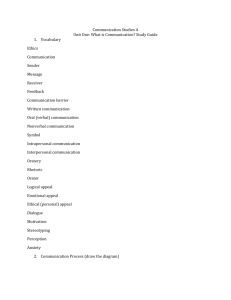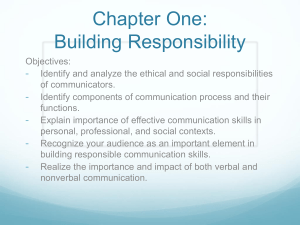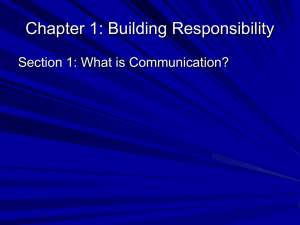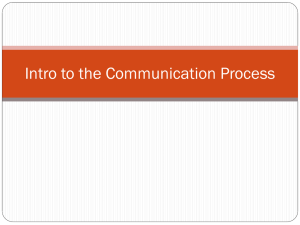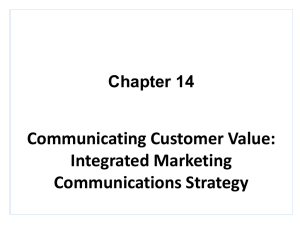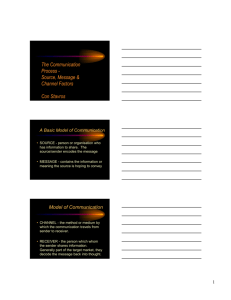Slide 1 - jfugitt322
advertisement
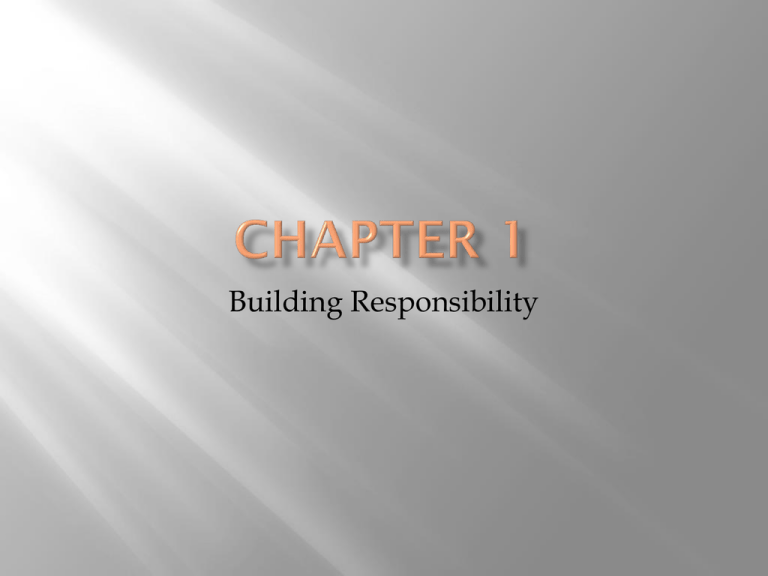
Building Responsibility Identify and analyze the ethical and social responsibilities you have Identify the components of the communication process Explain the importance of effective communication skills different contexts Recognize your audience as an important element in building responsible communication skills Realize the importance and impact of both verbal and nonverbal communication 1. What is Communication 2. Laying the Proper Foundation 3. Building the Proper Motivation Ethics Communication Sender Message Receiver Feedback Communication Barrier Written communication Oral communication Nonverbal communication Symbol Intrapersonal communication Interpersonal communication Oratory/rhetoric Orator Logical appeal Emotional appeal Ethical appeal Dialogue Motivation Stereotyping Ethics refers to a person’s sense of right and wrong Goes hand in hand with responsibility Ethical + Responsible = Successful Oral Communication The process of sending and receiving messages Occurs whenever we express ourselves in a manner that is clearly understood The Communication Process Sender Message Receiver Feedback Any obstacle that gets in the way Attitudinal Social Educational Cultural Environmental How do we get past these? Tips for the sender Think…before you speak Articulate…your words Watch… the receiver Tips for the receiver Ask… questions Learn…more about issues and people Relate…to the background of the speaker Written Oral or Verbal Nonverbal Facial expressions or body movements that express attitude or mood Symbols Anything that stands for an idea Peace sign, wave, “ok” sign Words: trust, honesty, family 1. Working to Be a Good Person 2. Communicating Constructively 3. Caring About Your Audience Words that are honest and have meaning Intrapersonal communication Depends on your ethics Can you be honest with yourself? Can you hold yourself responsible? Example Interpersonal Communication Messages transmitted between two or more people Not limited to formal speaking situations Oratory (rhetoric) The art or study of public speaking Orator – person who uses words effectively Sir Laurence Olivier “Performers can bring creative life to a play only if they respect the audience enough tot think that the audience will understand the play.” Questions to Consider Before Speaking Is this material appropriate? How would I feel if I were asked that question? Am I giving my audience new information? Is my material too difficult or too easy? Logical Appeal Emotional Appeal Sequence and analysis in your organization Factual evidence to prove your point “strike a chord” with emotions Touches on patriotism, family, justice, etc. Ethical Appeal Demonstrate a natural honesty Strong constitution regarding right and wrong No-comprimise approach to your values Motivation A need or desire that causes a person to act 2 Internal Forces for Motivation Words The desire to treat both people and situations fairly and to avoid stereotyping others The desire to set a good example for others Stereotyping Labeling every person in a group based on a preconceived idea as to what the group represents Football players lack intelligence Straight-A students are “nerds” Politicians are dishonest People, in general, are dishonest Don’t Let the Negative Stereotypes De-motivate You Set an Example What you say What you do Make People Believe! Section 1 – What is Communication? 4 Part Communication Process? Sender Message Receiver Feedback What are communication barriers? Section 2 – Laying the Proper Foundation 3 Elements of your Value Structure Foundation? Working to be a good person Communicating constructively Caring about your audience Difference between intrapersonal & interpersonal? What is “the art or study of public speaking?” Section 3 – Building the Proper Motivation What is the desire that causes a person to act? Read “What Symbols Can Say” p. 9 What term from Section 3 does Michael Green demonstrate?
